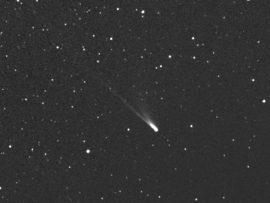- 96P/Machholz
-
96P/Machholz 
96P/Machholz as seen by STEREO-A in April 2007Discovery Discovered by: Donald Machholz Discovery date: 1986 Alternate designations: 96P, Machholz, Machholz 1, 1986 J2, 1991 XII, 1986e, 1986 VII Orbital characteristics A Epoch: 2452480.5 (July 25, 2002) Aphelion distance: 5.90347497 AU Perihelion distance: 0.12412874529142 AU Semi-major axis: 3.0138018588805 AU Eccentricity: 0.958813236203415 Orbital period: 5.2322 a Inclination: 60.1813131789455° Last perihelion: April 4, 2007[1]
January 8, 2002[1]Next perihelion: July 14, 2012 18:49[1][2] Comet 96P/Machholz or 96P/Machholz 1[3] is a short-period comet discovered on May 12, 1986 by amateur astronomer Donald Machholz in Loma Prieta, California.[3][4] Comet 96P/Machholz will next come to perihelion on July 14, 2012.[1]
Machholz 1 is unusual among comets in several respects. Its highly eccentric 5.2 year orbit has the smallest perihelion distance known among regular[5] short-period comets, bringing it considerably closer to the Sun than the orbit of Mercury. It is also the only known short-period comet with both high orbital inclination and high eccentricity.[6] Most short-period comets are thought to originate in the Kuiper belt, but this radically modified orbit implies a different and possibly extrasolar origin.[7] Machholz 1 was also recently found to be both carbon-depleted and cyanogen-depleted, a chemical composition nearly unique among comets with known compositions.[8][9]
Contents
Orbit
The orbit of Machholz 1 corresponds to the Arietids and the Marsden and Kracht Comet groups.[10] Its Tisserand parameter with respect to Jupiter, TJ, is also unusual.[6] 96P will not make another close approach to the Earth until 2028 when it will pass at a distance of 0.319 AU (47,700,000 km; 29,700,000 mi).[11]
Observations
Machholz 1 entered the field of view of the orbiting Solar and Heliospheric Observatory (SOHO) in 1996, 2002, and 2007, where it was seen by the corona-observing LASCO instrument in its C2 and C3 coronagraphs.[3][12] During the comet's last transit through perihelion in 2007, it appeared in SOHO's LASCO C3's field of view from April 2 to April 6, peaking in brightness on April 4, 2007.[13] In these observations, its coma was substantially smaller than the Sun in volume, but the forward scattering of light made the comet appear significantly brighter.[14]
Its predicted magnitude at this perihelion on April 3 was +2,[15] and it may have been visible to Earth-based observers very early in the morning.
The next opportunity to observe Machholz 1 will be when it returns to perihelion in 2012.[7]
Unusual composition
Spectrographic analysis of the coma of Machholz 1 was made during its 2007 apparition, as part of the Lowell Observatory comet composition long-term observing program.[16] When compared with the measured abundances of five molecular species in the comae of the other 150 comets in their database, these measurements showed Machholz 1 to have far fewer carbon molecules than the 150 other comets.[6] These other comets had on average 72 times as much cyanogen as Machholz 1.
The only comet previously seen with similar depletion both in carbon-chain molecules and cyanogens is Yanaka (1988r), but it has a substantially different orbit.[17]
Possible cause of the unusual chemical composition
There are currently three hypotheses to explain the chemical composition of Machholz 1.
Extrasolar origin
A leading hypothesis for the difference is that Machholz 1 comes from outside the Solar System and was captured by the Sun.[18]
Oort cloud origin
Other possibilities are that it formed in an extremely cold region of the solar system (such that most carbon gets trapped in other molecules).
Extreme thermal alteration
Given how close it approaches the Sun at perihelion, repeated baking by the Sun has stripped most of its cyanogen.
See also
- Interstellar comet
References
- ^ a b c d Seiichi Yoshida (2007-12-30). "96P/Machholz 1". aerith.net. http://www.aerith.net/comet/catalog/0096P/index.html. Retrieved 2011-04-06.
- ^ JPL HORIZONS 96P
- ^ a b c "96P/Machholz 1". cometography. pp. 1. http://cometography.com/pcomets/096p.html. Retrieved 2008-08-06.
- ^ "Astronomy magazine podcast: Don Machholz and Comet 96P". Astronomy.com. March 29, 2007. http://www.astronomy.com/asy/default.aspx?c=a&id=5378. Retrieved 2008-08-06.
- ^ A'Hearn, M. F.; Millis, R. L.; Schleicher, D. G.; Osip, D. J.; Birch, P. V. (1995). "The ensemble properties of comets: Results from narrowband photometry of 85 comets, 1976-1992.". Icarus 118 (2): 223–270. Bibcode 1995Icar..118..223A. doi:10.1006/icar.1995.1190.
- ^ a b c Schleicher, David G. (2008). "The Extremely Anomalous Molecular Abundances of Comet 96P/MACHHOLZ 1 from Narrowband Photometry". The Astronomical Journal 136 (5): 2204–2213. Bibcode 2008AJ....136.2204S. doi:10.1088/0004-6256/136/5/2204.
- ^ a b MacRobert, Alan (2008-12-02). "A Very Oddball Comet". Sky & Telescope magazine. http://www.skyandtelescope.com/news/35379224.html. Retrieved 2008-12-05.
- ^ "IAU Circular 8842". International Astronomical Union. 2007-06-06. http://www.cbat.eps.harvard.edu/iauc/08800/08842.html. Retrieved 2011-07-05.
- ^ Langland-Shula, Laura E.; Graeme H. Smith (2007). "The Unusual Spectrum of Comet 96P/Machholz". The Astrophysical Journal Letters (IOP publishing) 664 (2): L119–L122. Bibcode 2007ApJ...664L.119L. doi:10.1086/520839. http://www.iop.org/EJ/article/1538-4357/664/2/L119/21833.html.
- ^ Ohtsuka, Katsuhito; Nakano, Syuichi; Yohikawa, Makoto (February 2003). "On the Association among Periodic Comet 96P/Machholz, Arietids, the Marsden Comet Group, and the Kracht Comet Group.". Science Links Japan. http://sciencelinks.jp/j-east/article/200310/000020031003A0165629.php. Retrieved 2008-08-06.
- ^ "JPL Close-Approach Data: 96P/Machholz 1". 2007-08-12 last obs. http://ssd.jpl.nasa.gov/sbdb.cgi?sstr=96P;cad=1#cad. Retrieved 2011-09-13.
- ^ Boschat, Mike (January 7, 2002). "(meteorbs) Comet 96P/Machholz now in the SOHO C3 images". meteorbs. http://www.meteorobs.org/maillist/msg24835.html. Retrieved 2008-08-06.
- ^ Search for SOHO Realtime Data
- ^ Marcus, Joseph C. (2007). "Forward-Scattering Enhancement of Comet Brightness. I. Background and Model". International Comet Quarterly 29 (2): 39–66. Bibcode 2007ICQ....29...39M.
- ^ "96P/Machholz 1 (2007)". arieth.net. September 20, 2007. http://www.aerith.net/comet/catalog/0096P/2007.html. Retrieved 2008-08-06.
- ^ "A New Compositional Class of Comets: from Fire, Ice, or Beyond? Lowell Observatory Astronomer Confirms New Class of Comets". Lowell Observatory press release. 2008-12-02. http://www.lowell.edu/media/releases.php?release=20081202. Retrieved 2008-12-05.
- ^ Fink, Uwe (1992). "Comet Yanaka (1988r): A New Class of Carbon-Poor Comet". Science 257 (5078): 1926. Bibcode 1992Sci...257.1926F. doi:10.1126/science.257.5078.1926. PMID 17753496. http://www.sciencemag.org/cgi/content/abstract/257/5078/1926.
- ^ Odd Comet Possibly from Another Star System
External links
- NASA JPL Small-Body Database Browser on 96P/Machholz 1
- SOHO hotshots of comet
- video of 96P/ Machholz in STEREO HI1a
Periodic comets (by number) Previous
2060 Chiron96P/Machholz Next
97P/Metcalf-BrewingtonCategories:- Comets
Wikimedia Foundation. 2010.
